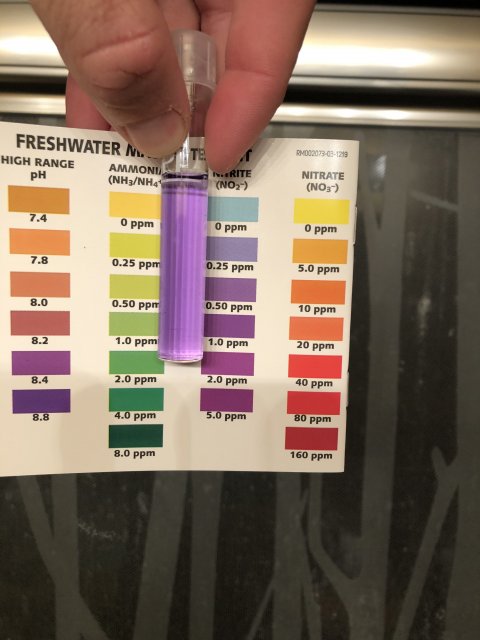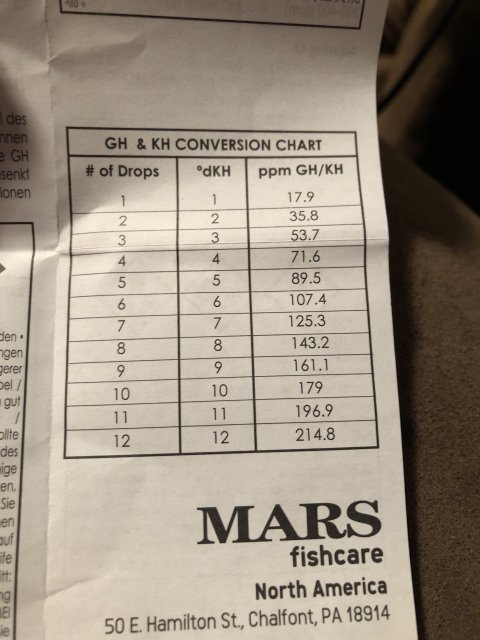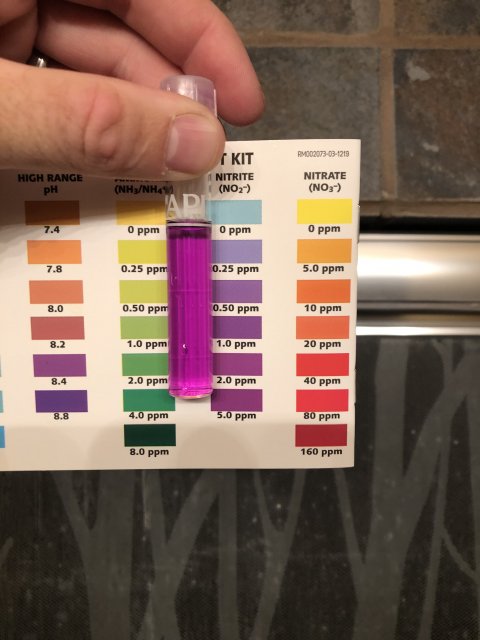KH in the tank is what matters the most. However, what is in your tap is where the baseline is. Since the test is so quick and easy, do both?
There is something in your water causing the process to be off. I am not sure if is is something actually slowing the bacterial reproduction rate and/or something affecting the colors of some of the test results. We know things are working because we see drops in ammonia and nitrite levels after adding ammonia. But what the science says should be happening is not.
Here is the problem.
- On Monday you dosed to 3 ppm of ammonia at about 9:30 am your time. You tested the ammonia tank at that time and reported it being 3 ppm and the nitrite at .25 ppm.
- On Tuesday, 22.5 hours later, you tested and reported "Ammonia - between 1 and 2 ppm"- this is a problem because it is not accurate. I do not know if your tank processed 1/3 or 2/3 of the ammonia. That is a big difference. You reported "Nitrites - to me looks to be .5 - 1 ppm." That is a rise in nitrite and it means ammonia is being converted faster than nitrite is being processed. You reported Nitrates 10-20 ppm. This shows nitrite is being processed.
- On Wednesday about 23 hours later you reported "This morning Ammonia - 1 ppm." Now there are only two options here. Either the prior day your ammonia was 2 and has dropped in half to 1 ppm or it was 1 ppm yesterday and no ammonia at all was processed. Therefore, one must assume your 1-2 ppm on Tuesday was most likely 2. But, if you processed 1 ppm in 24 hours the day before, then more than that should be processed in the following 24 hours, But it wasn't..
You reported "Nitrite - 1 ppm" That would have to mean it was either up from .5 or unchanged from 1. Neither of these conditions makes sense. If your ammonia bacteria handled 1 ppm of ammonia in the first day, it produced x Nitrite. And this showed up in the increase in nitrite of between .25 and .75 ppm. Then the next day another 1 ppm of ammonia was reported converted to what should be a similar amount of nitrite. The nitrite bacteria should also have been reproducing over the day such that they should have been able to process more nitrite. But the nitrite did not budge.
I keep coming back to the same conclusion. The numbers should not be what you are reporting. Only two possibilities exist that can cause this. Either you are doing something wrong in testing or there is something throwing off test results, or both. As I stated, cycling is a process. Add ammonia and it doesn't budge for a bit, then it starts to drop and then it does so faster. When the bacteria can convert 3 ppm of ammonia to 0 in 24 hours, you have all of them you need. The same applies to nitrite.
The difference between them is that dosing ammonia instantly creates the amount of ammonia that will normally take a whole day to make in the tank when it is fully stocked. But the nitrite is only created as fast as the ammonia bacteria makes it. So nitrite builds up but at an increasingly slower rate and then it peaks and drops. And the drop here is similar to how ammonia dropped, at an accelerating rate.
This is how the process works. While the exact time and the specific levels can vary from cycle to cycle, the process is the same. What I am seeing in your tank is not even close to following the process. I have asked you to test etc. as I have in such a way as to access what is going on in your tank. And, as you report results, I keep trying to figure out why they are not going as expected.
That leaves us in a strange place. I have to assume one of two things, the first is that your numbers are not accurate but what I am seeing suggests the tank is cycling. The second is there is something wrong and you are not able to get the tank cycled and I cannot say why that is. My gut says the tank is close to being cycled and the problem is the testing, for whatever reason.
So test again this evening. The numbers have to go down. If they do not, I am going to suggest a change in how to proceed from here. First, we will reduce the ammonia dosing by 1/3 and see what happens. If that doesn't change what test results we see, then what I am going to suggest is that you do a big water change and then begin to stock, but not all at once. I am more concerned that nitrite rather than ammonia might be a problem. But that can easily be handled by adding a small amount of salt to the water. And it is easy to spot nitrite issues in a stocked tank, the fish will act as if they need oxygen. Chloride from salt will fix this fast, but I have a hunch it will not be an issue.
Over the years I have occasionally run into such a stubborn situation as this one appears to be. I have learned in such cases to trust that the process is working but that testing is not. The bacteria do not turn off and on back and forth. Either they are there and multiplying as needed or they are not. Since you manage to change ammonia and nitrite readingst on the downside, there has to be bacteria at work. And this means the process is happening. There are too many hints which support this.





